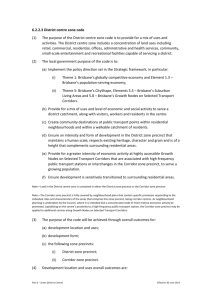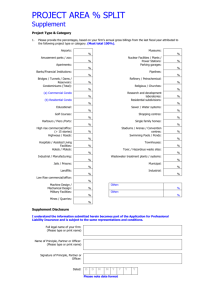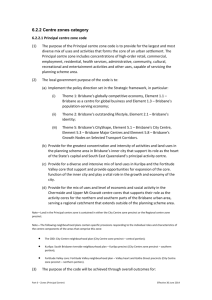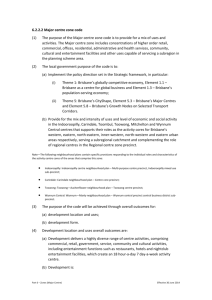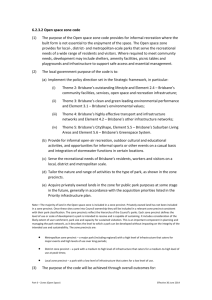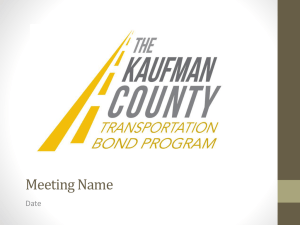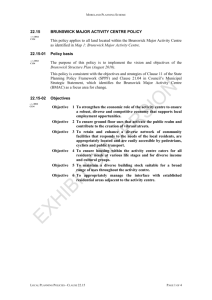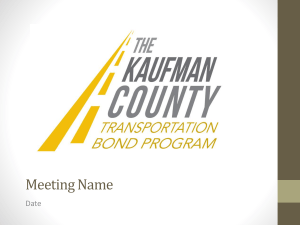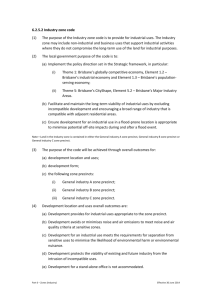Mixed use zone code - Brisbane City Council
advertisement
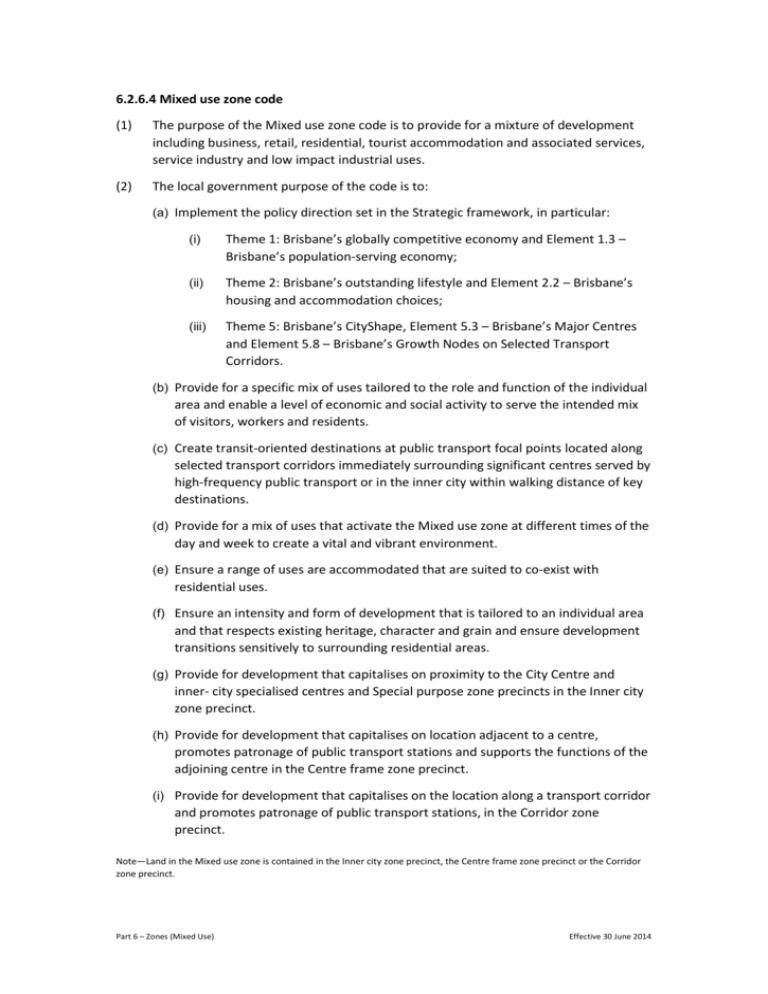
6.2.6.4 Mixed use zone code (1) The purpose of the Mixed use zone code is to provide for a mixture of development including business, retail, residential, tourist accommodation and associated services, service industry and low impact industrial uses. (2) The local government purpose of the code is to: (a) Implement the policy direction set in the Strategic framework, in particular: (i) Theme 1: Brisbane’s globally competitive economy and Element 1.3 – Brisbane’s population-serving economy; (ii) Theme 2: Brisbane’s outstanding lifestyle and Element 2.2 – Brisbane’s housing and accommodation choices; (iii) Theme 5: Brisbane’s CityShape, Element 5.3 – Brisbane’s Major Centres and Element 5.8 – Brisbane’s Growth Nodes on Selected Transport Corridors. (b) Provide for a specific mix of uses tailored to the role and function of the individual area and enable a level of economic and social activity to serve the intended mix of visitors, workers and residents. (c) Create transit-oriented destinations at public transport focal points located along selected transport corridors immediately surrounding significant centres served by high-frequency public transport or in the inner city within walking distance of key destinations. (d) Provide for a mix of uses that activate the Mixed use zone at different times of the day and week to create a vital and vibrant environment. (e) Ensure a range of uses are accommodated that are suited to co-exist with residential uses. (f) Ensure an intensity and form of development that is tailored to an individual area and that respects existing heritage, character and grain and ensure development transitions sensitively to surrounding residential areas. (g) Provide for development that capitalises on proximity to the City Centre and inner- city specialised centres and Special purpose zone precincts in the Inner city zone precinct. (h) Provide for development that capitalises on location adjacent to a centre, promotes patronage of public transport stations and supports the functions of the adjoining centre in the Centre frame zone precinct. (i) Provide for development that capitalises on the location along a transport corridor and promotes patronage of public transport stations, in the Corridor zone precinct. Note—Land in the Mixed use zone is contained in the Inner city zone precinct, the Centre frame zone precinct or the Corridor zone precinct. Part 6 – Zones (Mixed Use) Effective 30 June 2014 Note—Land in this zone is fully covered by neighbourhood plans that contain specific provisions that respond to the individual roles and characteristics of the areas that comprise this zone. Note—As neighbourhood planning is undertaken by the Council, where it is intended that a specific mixed use environment, distinguishable from centres, is to be promoted, capitalising on the location’s proximity to the City Centre or a high-frequency public transport station, the Mixed use zone may be applied to further lands in the inner city, around significant centres or Growth Nodes on Selected Transport Corridors. (3) The purpose of the code will be achieved through overall outcomes for: (a) development location and uses; (b) development form; (c) the following zone precincts: (4) (i) Centre frame zone precinct; (ii) Corridor zone precinct; (iii) Inner city zone precinct. Development location and uses overall outcomes are: (a) Development provides for commercial, retail, residential, government, service, community and cultural activities with the preferred mix and emphasis of uses: (i) tailored to the specific location and role of the individual area; (ii) consistent with the location-specific provisions in the relevant neighbourhood plan. (b) Development for retail functions complements rather than competes with centres and does not contain large-scale supermarkets unless specified in a neighbourhood plan. (c) Development supports a transit-oriented environment. (d) Development for a use that involves a high dependency on cars, including parking stations where a car park, car wash or service station, or that is located in an area that does not benefit from high public transport accessibility is not accommodated in the Mixed use zone. (e) Development for entertainment functions operating for extended hours or uses that have the potential to generate wider patronage, such as hotels and nightclub entertainment facilities, are not accommodated within the Mixed use zone. (f) Development for a restaurant is appropriately scaled, positioned and operated to serve the residents and patrons of the Mixed use zone. (g) Development for a residential use: (i) does not compromise the provision of an active street frontage where identified in a neighbourhood plan; (ii) supports the creation of a walkable centre with the potential for residents to live within walking distance of high-frequency public transport, employment, entertainment and community facilities existing Part 6 – Zones (Mixed Use) Effective 30 June 2014 within the Mixed use zone and reduces vehicle-based trips to work, shops and centres; (iii) provides a wide choice in housing sizes and housing adaptability that meets the needs of a diverse population and responds to residents’ changing life-cycle needs; (iv) may include a home based business where it is of a scale and nature that protects the amenity of adjoining residents. (h) Development for residential accommodation such as rooming accommodation, a residential care facility or a retirement facility may be suitable within the Mixed use zone where it is consistent with the urban form and primary functions of the area as identified in neighbourhood plans. (i) Development is designed, sited and constructed to minimise noise, odour and air- quality impacts on residents consistent with its location in the Mixed use zone, although residents cannot expect to enjoy the same level of noise, odour and airquality amenity as the low density suburban areas (due to the levels of activity envisaged during the day and evening). (j) Development for a use that is often provided in a large format such as hardware and trade supplies, garden centre or showroom: (5) (i) is limited in area and frontage; (ii) provides the level of activation and interface with the street expected of other non-residential uses in the Mixed use zone. Development form overall outcomes are: (a) Development of buildings is of a height, bulk, scale and form tailored to its specific location and to the characteristics of the site including: (i) the nature of the surrounding neighbourhood; (ii) proximity to and frequency of public transport networks and services. (b) Development provides a built form that creates a consistent and cohesive streetscape and continuous pedestrian connections and shelter. (c) Development addresses and interfaces with the street and other adjoining public spaces and provides surveillance of the public domain. (d) Development provides consistent and cohesive landscape and streetscape treatments, including deep planting, that reinforce the Mixed use zone identity and functionality of public spaces and footpaths, provide breathing spaces and encourage outdoor activity. (e) Development on large sites: (i) Part 6 – Zones (Mixed Use) is integrated and coordinated both within the site and in relation to surrounding land uses; Effective 30 June 2014 (ii) provides clear, direct, safe and comfortable internal fine-grained connectivity for pedestrians to key destinations in the vicinity, including to public transport services, active transport links and to public spaces within surrounding land uses. (f) Development provides vehicular access arrangements that minimise impacts on surrounding land, including amenity and pedestrian connectivity, and protects the functionality of both local and higher order road networks. (g) Development is sensitively designed and operated to avoid or mitigate any potential adverse impact on an adjoining use. (h) Development responds to land constraints, mitigates any adverse impacts on environmental values and addresses other specific characteristics as identified by overlays affecting the site or in codes applicable to the development. (6) Inner city zone precinct overall outcomes are: (a) Development provides for a specific mix of uses that respond to a particular location within the inner city and ensure that the use is appropriate given its proximity to the City Centre and surrounding specialised centres, Special purpose zone precincts and residential areas. (7) Centre frame zone precinct overall outcomes are: (a) Development creates a mixed use environment that complements and supports, but is distinguished from and does not compete with, the retail and entertainment functions of adjoining centres. (b) Development diversifies the range of activities and functions available in the vicinity, including the commercial, residential and community uses that complement the retail focus of adjoining centres. (8) Corridor zone precinct overall outcomes are: (a) Development creates a mixed use environment that capitalises on transport accessibility along Selected Transport Corridors and is of an intensity and form that is tailored to the area’s location along the transport corridor and to the relationship with Growth Nodes on Selected Transport Corridors. Part 6 – Zones (Mixed Use) Effective 30 June 2014
